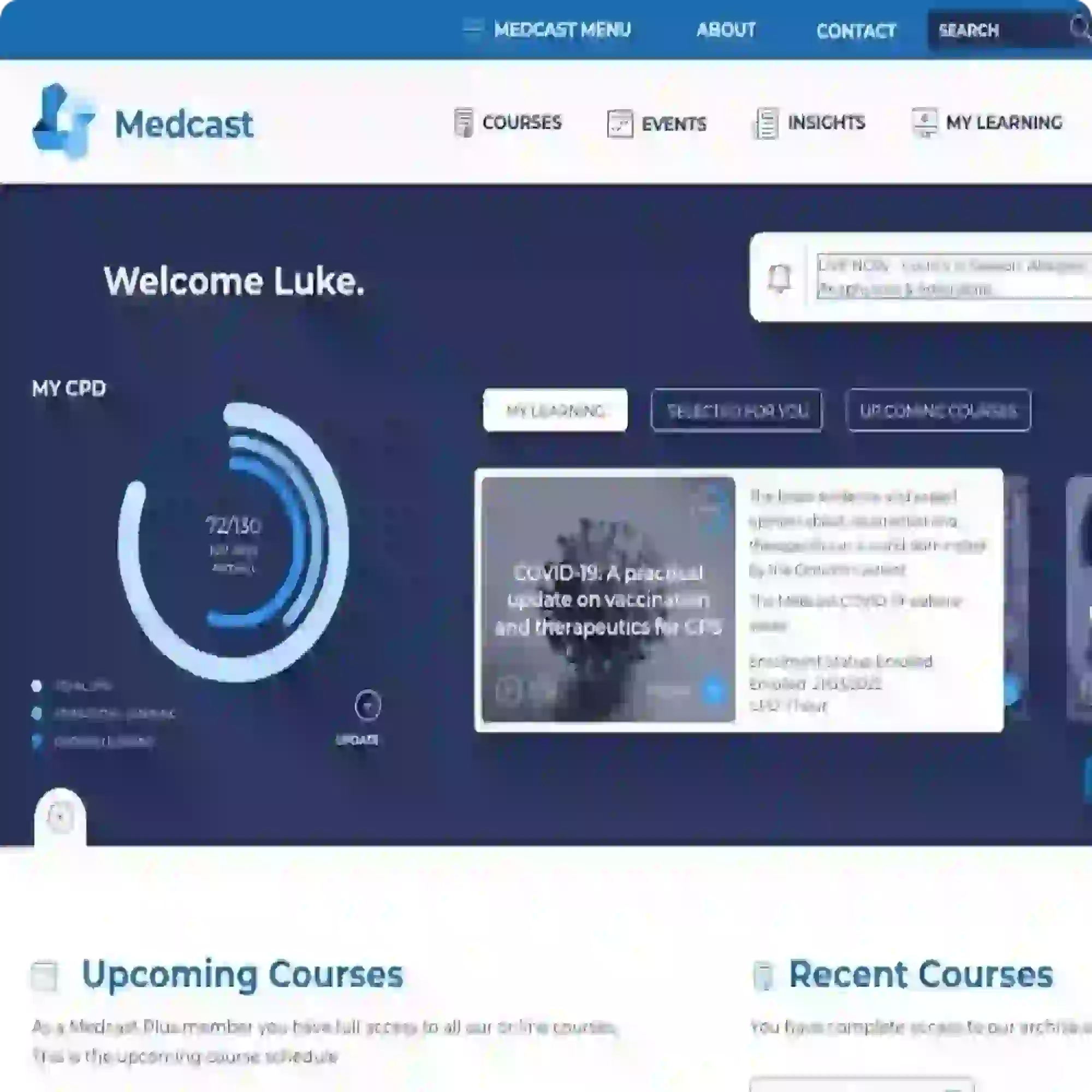Hepatitis C - clinical fact sheet and MCQ
Overview
Hepatitis C virus (HCV) infection remains a significant public health issue in Australia, with approximately 118,000 people living with chronic infection. Transmission predominantly occurs by contact with infected blood, usually by sharing needles or syringes for injecting drugs. It can also occur with unsafe piercing, tattooing and medical or dental procedures. Mother-to-child transmission can occur during pregnancy and delivery. Sexual transmission may occur if there is blood exposure during sexual activity.
Chronic HCV infection can lead to progressive liver fibrosis, cirrhosis, hepatocellular carcinoma (HCC) and liver failure. Fortunately, HCV is curable in most cases with direct-acting antivirals (DAAs), leading to improved quality of life, reduced transmission, and reduced mortality.
Diagnosis of hepatitis C
1. Screening
Testing is recommended for individuals with identifiable risk factors, including:
-
people who inject drugs (PWID)
-
those with a history of incarceration
-
recipients of blood products before 1990
-
individuals from high-prevalence regions (eg Africa, Middle East, South Asia, Eastern Europe, the Mediterranean)
-
men who have sex with men (particularly if HIV-positive)
|
When to Screen |
Test to Order |
Interpretation and Next Steps |
|
Presence of risk factors (ie as listed above) |
HCV antibody (Ab) test with reflex HCV RNA (qualitative) |
|
|
HCV Ab negative |
No evidence of past or current HCV infection |
If ongoing risk factors: re-test HCV Ab annually |
|
HCV Ab positive, HCV RNA negative |
Past infection, cleared spontaneously or after treatment |
No further action unless ongoing risk factors; re-test RNA annually |
|
HCV Ab positive, HCV RNA positive |
Chronic HCV infection |
Proceed to full pre-treatment assessment and offer treatment |
|
Recent potential exposure (<6 months) |
Consider HCV Ab and early RNA testing |
If recent exposure suspected, repeat testing to detect seroconversion |
|
People with ongoing high-risk behaviours |
Annual screening (HCV Ab or HCV RNA as appropriate) |
|
|
Difficulty accessing veins (eg PWID) |
Dry blood spot (DBS) or point-of-care testing (where available) |
Confirmatory standard HCV RNA testing required if DBS positive |
Point-of-care testing using the TGA approved Xpert® HCV RNA assay provides rapid and reliable diagnosis, particularly in high-prevalence settings.
2. Differential diagnoses
Consider other causes of liver dysfunction such as:
-
hepatitis B virus (HBV)
-
alcohol-related liver disease
-
metabolic dysfunction-associated steatotic liver disease (MASLD) (previously termed non-alcoholic fatty liver disease)
3. Red flags
Urgent referral to a specialist is warranted if:
-
cirrhosis is suspected (eg clinical signs, APRI ≥1.0 (explained below) or Fibroscan® >12.5 kPa as discussed below)
-
co-infection with HIV or HBV
-
significant renal impairment (eGFR <50 mL/min)
-
previous unsuccessful HCV treatment
Management of hepatitis C
Acute viral hepatitis C is a notifiable disease in Australia.
1. Pre-treatment assessment
Key assessments include:
-
liver function tests, full blood count, and renal function
-
evaluation for liver fibrosis using non-invasive methods (APRI score or FibroScan®)
-
the AST to platelet ratio index (APRI) score is a simple, widely available tool to estimate fibrosis stage
-
an APRI score of less than 1.0 indicates that cirrhosis is unlikely, whereas a score of 1.0 or greater suggests possible cirrhosis
-
FibroScan® is a non-invasive imaging technique (transient elastography) that measures liver stiffness
-
FibroScan® values > 12.5 kPa are consistent with cirrhosis and require specialist evaluation
-
screening for HBV and HIV co-infections
-
review of medications for potential drug interactions
Counselling should address adherence, lifestyle factors (eg alcohol reduction), and prevention of reinfection.
2. Treatment for hepatitis C
All adults with detectable HCV RNA should be considered for treatment, regardless of fibrosis stage. In the absence of contraindications, treatment choice may be guided by patient preference.
The primary regimens are:
-
sofosbuvir/velpatasvir (SOF/VEL): one tablet daily for 12 weeks
-
contraindicated with concomitant use of amiodarone
OR
-
glecaprevir/pibrentasvir (GLE/PIB): three tablets daily for 8 weeks (or 12 weeks if cirrhosis present)
-
contraindicated in moderate or severe hepatic impairment
GPs experienced in HCV management can prescribe DAAs independently; otherwise, consultation with a specialist is advised. Referral of the patient for treatment is not necessary except in the presence of cirrhosis, co-infections, or complex comorbidities.
Monitoring during treatment is usually minimal, focused on adherence and managing any side effects. Testing during treatment is not required.
3. Follow-up
-
Confirm cure with HCV RNA testing at or beyond 4 weeks post-treatment (SVR4)
-
Continue liver disease surveillance if cirrhosis is present, including 6-monthly ultrasound for HCC screening
4. Special considerations
-
Treatment is not recommended during pregnancy and breastfeeding
-
Incarcerated individuals, Aboriginal and Torres Strait Islander peoples, and rural populations may benefit from tailored models of care
-
Annual screening is recommended for individuals with ongoing risk factors
5. Contact tracing
Contact tracing is high priority for the following:
-
needle-sharing partners of HCV Ab+ individuals
-
current blood donors, who have donated within 12 months prior to testing positive
-
blood donor recipients who received donated blood products before 1990
-
children of infected mothers
-
sexual partners of gay, bisexual, and other men who have sex with men if HIV-positive
Contact tracing for sexual partners of people with hepatitis C is otherwise low priority.
More guidance on contact tracing can be found here.
References
Hepatitis C Virus Infection Consensus Statement Working Group. Australian recommendations for the management of hepatitis C virus infection: a consensus statement (2022). Melbourne: Gastroenterological Society of Australia, 2022.
Muller K, Hasan M. Treating chronic hepatitis C in general practice. AJGP. 2021;50(10):697-701.
Australasian Society for HIV, Viral Hepatitis and Sexual Health Medicine (ASHM). Decision Making in Hepatitis C. 2024. (last accessed May 2025).
Australasian Society for HIV, Viral Hepatitis and Sexual Health Medicine (ASHM). Hepatitis C. 2022. (last accessed May 2025).
Claim your CPD
After reading the clinical summary above and reviewing the references, complete the quiz to gain 30 minutes of EA CPD and 30 minutes of RP CPD.
You can either self-report CPD to your CPD home, or Medcast will track your learning via your personal CPD Tracker and you can download and report these points once a year. See our CPD Tracker FAQ.
Quiz
Please log in or sign up for a free Medcast account to access the case study questions and achieve the CPD credits.
The Medcast medical education team is a group of highly experienced, practicing GPs, health professionals and medical writers.
Become a member and get unlimited access to 100s of hours of premium education.
Learn moreCo-billing and split billing are often a source of confusion for many GPs. This FastTrack clearly defines these two methods of billing, including examples, explanations of when it is and isn’t appropriate to co- or split bill, and common compliance pitfalls. 30 mins each RP and EA available with the quiz.
The Coordinated Veterans’ Care (CVC) Program is a DVA initiative that allows GPs to provide structured, proactive care in the community for eligible veterans and war widows. This FastTrack provides a guide to billing the CVC program, and outlines a strategy for its practice-wide integration.
Achilles tendinopathy is a common cause of posterior heel pain and functional impairment. GPs are well-placed to coordinate care for these patients. This FastTrack fact sheet provides a concise summary of diagnosis and non-surgical management, including when to refer. Earn 30mins each RP and EA CPD with the quiz.

